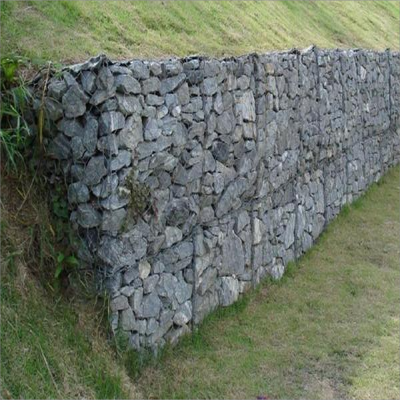1. Material composition
1、Three dimensional composite drainage network:
Three-dimensional composite drainage net is a new type of geosynthetic material composed of three-dimensional plastic net bonded with water-permeable geotextile on both sides. Its core structure is a three-dimensional geonet core with needle-punched perforated non-woven geotextile glued on both sides. The mesh core is generally made of high-density polyethylene raw material, and anti-UV and anti-oxidation stabilizers are added to enhance its durability. So, it has very good drainage properties and compressive strength.
2、Gabion mesh:
Gabion mesh is made of high strength, high corrosion resistance low carbon steel wire or clad PVC The steel wire uses a mechanically woven hexagonal mesh. After cutting, folding and other processes, these mesh pieces are made into box-shaped mesh cages, and a gabion cage is formed after being filled with stones. The material composition of gabion mesh mainly depends on the strength and corrosion resistance of steel wire, as well as the stability and water permeability of filling stone.
2. Functional characteristics
1、Three dimensional composite drainage network:
The main function of three-dimensional composite drainage net is drainage and protection. Its three-dimensional structure can quickly drain groundwater and prevent the soil from softening or losing due to accumulated water. The reverse filtration effect of geotextile can prevent soil particles from entering the drainage channel and keep the drainage system unblocked. It also has certain compressive strength and load capacity, which can enhance the stability of soil.
2、Gabion mesh:
The main function of gabion net is support and protection. Its box-shaped structure can be filled with stones to form a stable support body, which can resist water erosion and soil sliding. The water permeability of gabion net is very good, so a natural drainage channel can be formed between the stones filled inside it, lowering the groundwater level and reducing the water pressure behind the wall. The gabion net also has a certain deformation ability, which can adapt to the uneven settlement of the foundation and the change of terrain.
3. Application scenarios
1、Three dimensional composite drainage network:
Three-dimensional composite drainage network is commonly used in drainage projects of landfill, subgrade and tunnel inner wall. In transportation infrastructure such as railways and highways, it can prolong the service life of roads and improve safety. It can also be used in underground structure drainage, retaining wall back drainage and other projects.
2、Gabion mesh:
Gabion net is mainly used in water conservancy engineering, traffic engineering, municipal engineering and other fields. In water conservancy projects, gabion nets can be used in the protection and reinforcement of rivers, slopes, coasts and other places; In traffic engineering, it is used for slope support and retaining wall construction of railways, highways and other traffic facilities; In municipal engineering, it is used in urban river reconstruction, urban park landscape construction and other projects.

4. Construction and installation
1、Three dimensional composite drainage network:
The construction and installation of three-dimensional composite drainage network is relatively simple and fast.
(1)Clean and clean the construction site, and then lay the drainage net flat on the site according to the design requirements.
(2)When the length of the drainage site exceeds the length of the drainage net, nylon buckles and other connection methods should be used for connection.
(3)Fixing and sealing the drainage net with the surrounding geomaterials or structures to ensure the smooth and stable drainage system.
2、Gabion mesh:
The construction and installation of gabion net is relatively complicated.
(1)The gabion cage should be made according to the design drawings and transported to the construction site.
(2)Assemble and shape the gabion cage according to the design requirements, and then lay it on the finished soil slope or excavated excavation.
(3)The gabion cage is filled with stones and tamped and leveled.
(4)Laying geotextile or other protective treatment on the surface of gabion cage can enhance its stability and durability.
Post time: Apr-02-2025



